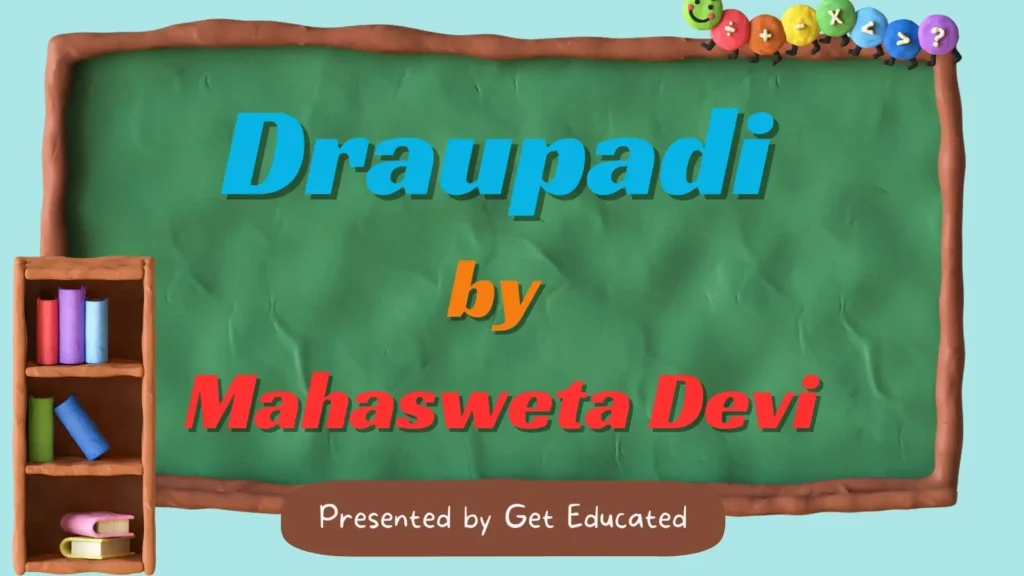
Indian Literature is abundant in the projection of consignment of women’s servitude and inhuman treatment of men. It raises the voice of resistance against patriarchal oppression in society in order to emancipate women with dignity and identity. It also focuses on the reconstruction of womanhood which emphasizes on the reordering of social and familial relationship with financial undependability of women. The woman who is considered ‘subaltern’ can as well ‘resist and ‘speak’ when pushed to the ultimate margin. A particular concern for women and their issues make Mahasweta Devi’s texts great areas of feminist research. Two forms of resistance are displayed by Mahasweta Devi in her story Draupadi – first is in the form of tribal insurgencies and the second is acted out by Dopdi Mejhan who is an active worker of the Naxalbari movement and is haunted down and raped in an attempt to conquer revolutionary groups.
Draupadi is a story about Dopdi Mehjen, a woman who belongs to the Santhal tribe of West Bengal. She is a Robin Hood-like figure who with her husband, Dhulna, murders wealthy landlords and usurp their wells, which is the primary source of water for the village. The government attempts to subjugate these tribal rebel groups through many means: kidnapping, murder, rape. Dopdi is captured by Officer Senanayak who instructs the army officers to rape her to extract information about the rebel uprising.
Ironically, the same officers who violated her body, insist that she covers up once she is ‘done with’. Intransigently, Dopdi rips off her clothes and walks towards officer Senanayak, “…naked. Thigh and pubic hair matted with dry blood. Two breasts. Two wounds”. Senanayak is shocked by her defiance as she stands before him “with her hand on her hip” as “the object of [his] search” and exclaims, “There isn’t a man here that I should be ashamed.”
Suggested Reading :
Draupadi as a Subaltern Text
Dopdi is a woman of strong mind and will as she defied the shame associated with rape and sexual abuse, which is extremely relevant to India today. Especially in the onset of the movement where many brave women came forward with their stories. Due to reading Draupadi with the knowledge that it was translated by Spivak I was constantly reminiscent of her essays: Can the Subaltern Speak? (1983) and The Trajectory of Subaltern in my Work (2003). Devi’s representation of Dopdi encapsulates what Spivak means by a gendered subaltern. Through the dislocation of the epic princess Draupadi to the tribal rebel Dopdi, Devi is able to present voices and perspectives otherwise unspoken and unheard of.
The Hindu mythology of the subaltern female body which is never questioned and only ever exploited is rejected by Devi. For example Goddess Durga in her form of Sati, ‘a good wife,’ self-immolates her body in pain over her father’s abuse of her husband, Lord Shiva. Enraged, Lord Shiva dances over the universe with Sati’s body on his shoulder. Lord Vishnu then dismembers her body, and her body parts are strewn over the universe. Each relic of Sati’s body becomes a place for worship and pilgrimage. Also in the Mahabharata, Draupadi’s marriage to all the Pandavas and her re-virginisation is another way in which the female body is exploited. In both, the case of Durga and Draupadi, what happens to their body is a result of patriarchal voices which denies them agency. The character of Dopdi allows us to view the subaltern’s identity vis-à-vis the hegemonic structures seen through the policemen and Officer Senanayek. Thus, Dopdi’s body becomes a site of both the exertion of authoritarian power and of gendered resistance. Dopdi bears the torture as she is raped by many men through the encouragement of the voice of another man Arijit, that urges her to save her comrades and not herself. However, the attack on her body fades this male authority’s voice as she candidly reacts to the police. Her refusal to be clothed goes against the phallocentric power, and the exploitation of her body gives her the agency to step away from the hegemonic patriarchy of the policemen.
Devi illustrates how any conflict or war results in the women’s body being the primary targets of attack by men. In the contexts of both the Naxalite movement and the Bangladesh Liberation war, both men and women are tortured, but it is much worse for women as they additionally undergo sexual abuse. Thus with Spivak’s concepts on the subaltern in mind, through Dopdi, Devi represents the gendered subaltern subject who exists at the periphery of society and dares to go against the existing patriarchal structures. Spivak has shown concern regarding the representation of the subaltern in the mainstream discourse on the basis that the subaltern cannot be represented; only re-presented. However, Devi’s use of polyphony not just re-presents the subaltern, it also explores the politics around the category of the ‘subaltern.’ Although there are many facets to the mythical Draupadi’s character, Devi focuses on the infamous incident where the princess is almost disrobed and subverts it to suit Dopdi’s context. Devi has always said that she is interested in the stories of ordinary people which is evident through the subversion of Draupadi’s rape.
Towards the latter part of her life, she focused on presenting the narratives of ordinary people. In Draupadi, Devi has not allowed her female protagonist, Dopdi, to be submissive and conquered by the male-dominated society, unlike Draupadi from the Mahabharata. Draupadi is a narrative that is universal in its portrayal of women as the most brutal victims of conflict and war. This approval on the part of Officer Senanayak in the story for the officers to ‘make her’ is reminiscent of the situation of Bangladesh’s Birangona and Japan’s comfort women. At the end of the story as she confronts the army officers with her bare body, the body that was violated and tortured is also in reverse used as a weapon. Even though Dopdi has been physically abused, she refuses to be emotionally wounded.
In Draupadi, Devi presents a strong woman who despite being marginalised and exploited, transgresses conventional sexual and societal standards. Dopdi subverts the physicality of her body from powerlessness into powerful resistance. She does not represent the tribal woman by romanticising her depiction of Dopdi but instead realistically re-presents her through simple language and complex emotions. Draupadi recognises a woman’s body as an asset through which they can resist the socio-political objectification of their bodies and overcome oppression.
To sum up, we can say that being a product of the third world, Mahasweta Devi is aware of the different forms of victimization that the women face in the society one way or the other. In Draupadi, she has taken the case of Dopdi with a mythical parallel from the epic. She does not romanticize Dopdi but presents her case, her subjection to male tyranny as she becomes the victim of the lust in male dominant world. Draupadi is unlike any other female characters in the stories of Mahasweta Devi. She is the representation of a female figure ready to stand up for her rights and her beliefs, and is the only female to maintain power over her torturer. She can make Senanayak feel the fear. In short, she asserts herself as the male figure and Senanayak becomes the female figure. He is terrified by Draupadi and is unable to anticipate her next move. So, Draupadi is representative of millions of tribal women who are fighting against oppression and who can dare to challenge imperialism and patriarchy. The tribal woman is marginalized in more than one way as she lives in a constant fear of victimization. This clearly shows that Mahasweta Devi’s Draupadi is a metaphorical resistance through an elegy of the subaltern.
